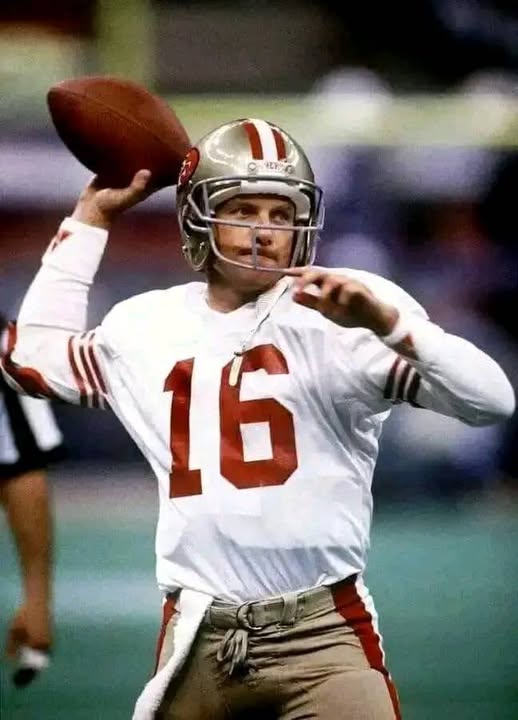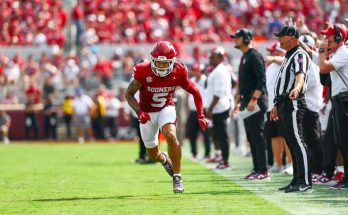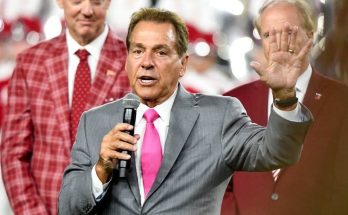I don’t care how many rings Tom Brady has—this man is the true GOAT at quarterback. Joe Clifford Montana Jr. was the greatest quarterback I’ve ever seen. He played in an era where defenses could maul receivers, where quarterbacks weren’t coddled by rules, and where the game was won with precision, poise, and ice-cold nerves rather than inflated stats and longevity. While Brady’s seven Super Bowl rings are impressive, they don’t automatically crown him as the best to ever do it. When you break down the film, the circumstances, and the sheer dominance under pressure, Montana stands alone.
The Era of Real Football
Let’s start with the most obvious difference: the eras in which these two legends played. Montana played in the 1980s and early 1990s, a time when defensive backs could mug receivers downfield, when pass rushers could actually hit the quarterback without drawing a flag, and when the game was far more physical. Brady, on the other hand, spent the majority of his career in an NFL that increasingly protected quarterbacks and offensive players. The league changed rules to favor passing offenses, making it easier for QBs to put up gaudy numbers. Montana didn’t have that luxury.
Montana operated in an era where a quarterback had to be tough, both mentally and physically. He took hits that would get defenders fined or suspended today. He made throws knowing that his receivers would get blasted the second the ball arrived. And yet, despite the brutality of the game, Montana thrived. His ability to read defenses, deliver pinpoint passes, and remain unshaken in the biggest moments was unparalleled.
The Ultimate Big-Game Performer
When it comes to the biggest stage, no one was better than Joe Montana. He went 4-0 in Super Bowls, throwing 11 touchdowns with zero interceptions. Let that sink in—not a single interception in four Super Bowl appearances. His passer rating in those games? A staggering 127.8. He didn’t just win; he dominated.
Compare that to Brady, who, despite his seven rings, has lost three Super Bowls and threw critical interceptions in some of those losses. Brady’s Super Bowl performances were often a mix of brilliance and mediocrity—his first three rings came on the back of dominant defenses and clutch kicks rather than outright quarterback masterclasses. Montana, on the other hand, was the driving force behind every one of his championships.
The most iconic moment of Montana’s career—The Drive against the Cincinnati Bengals in Super Bowl XXIII—epitomizes his greatness. Trailing 16-13 with just over three minutes left, Montana engineered a 92-yard touchdown drive, culminating in the legendary game-winning pass to John Taylor with 34 seconds left. That wasn’t just skill; that was sheer will. Montana didn’t need overtime, questionable calls, or last-second field goals to win. He simply took over when it mattered most.
The System Quarterback Argument (And Why It’s Wrong)
One of the most common criticisms against Montana is that he was a “system quarterback,” a product of Bill Walsh’s revolutionary West Coast offense. But this argument falls apart under scrutiny. Yes, Walsh’s system was brilliant, but it was Montana who made it work at the highest level. The offense relied on timing, precision, and quick decision-making—qualities that Montana had in abundance.
Brady, too, was part of a system—one designed by Bill Belichick that emphasized adaptability and exploiting weaknesses. Yet no one dismisses Brady’s accomplishments by calling him a “system QB.” The truth is, every great quarterback benefits from a great coach and scheme. What separates the best is how they perform within that system, and Montana did it better than anyone.
The Clutch Gene
If there’s one thing that defines Joe Montana, it’s his unshakable calm under pressure. He wasn’t just good in big moments—he was otherworldly. His nickname, “Joe Cool,” was earned through countless game-winning drives and impossible comebacks. He played with a quiet confidence that elevated everyone around him.
Brady, of course, has his own legacy of comebacks, but even his most ardent supporters can’t deny that he’s had his share of playoff meltdowns. His three Super Bowl losses include some of his worst performances—particularly against the New York Giants, where he was outplayed by Eli Manning twice. Montana never had that problem. When the lights were brightest, he was at his best.
The Stats Don’t Lie (Even If They Don’t Tell the Whole Story)
Statistically, Brady has the edge in volume—more passing yards, more touchdowns, more wins. But Montana’s efficiency was unmatched. He led the league in completion percentage five times, something Brady never did. His career passer rating of 92.3 was elite for his era, and his playoff numbers (especially in the Super Bowl) are untouchable.
Brady’s longevity is impressive, but longevity doesn’t automatically equal greatness. Montana’s peak was higher. From 1987 to 1990, he was virtually unstoppable, winning two MVPs and two Super Bowls while posting some of the most efficient seasons in NFL history. If not for injuries and an early retirement (by today’s standards), Montana’s numbers would be even more staggering.
The Eye Test
If you watch the film, Montana’s brilliance is undeniable. His footwork, his release, his ability to extend plays—everything was smooth, effortless, and deadly accurate. He made throws that modern QBs wouldn’t even attempt because the windows were so tight. And he did it without the benefit of today’s pass-friendly rules.
Brady was a master of the short-to-intermediate passing game, but Montana could make every throw—deep outs, back-shoulder fades, and touch passes over linebackers. He was the complete quarterback in a way few have ever been.



